NDVI stands for "Normalized Difference Vegetation Index". NRG stands for "Near-infrared / Red / Green". NDVI and NRG are both ways to visualize the amounts of infrared and other wavelengths of light reflected from vegetation. Because both these methods compare ratios of blue and red light absorbed versus green and IR light reflected, they can be used to evaluate the health of vegetation. It's a snapshot of how much photosynthesis is happening. This is helpful in assessing vegetative health or stress. (Read more here: https://www.agronomy.org/publications/jeq/articles/36/3/832) ## Do-It-Yourself These techniques for vegetation analysis were developed for satellite imagery, but at Public Lab, we've been working a lot on capturing infrared imagery using our DIY [near-infrared camera](/wiki/near-infrared-camera) setup, and combining it with visible bands to produce NDVI images such as the one above. ## What these images mean What exactly are these images we're trying to make? What do they tell us about vegetation, and why? These diagrams should help to understand what it is we're doing and why these are good ways to analyze plant life. ## The NDVI equation [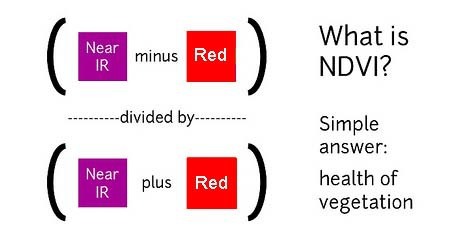](/i/44723) **NDVI = (Near Infrared - Red)/(Near Infrared + Red)** NDVI is a ratio which tries to emphasize photosynthesis while filtering out sun glare. The above equation is run for every pixel, using source data from an infrared photo and a visible light photo, like this pair: [](https://publiclab.org/system/images/photos/000/021/771/original/5390895115_c9d4d38fec_o.jpg) The result can be false-colored to make the high-photosynthesis areas more clear, and used to examine where plants are and how healthy they are. [](https://publiclab.org/system/images/photos/000/021/770/original/PetVISNDVIcomp.png) _Figure above: Normal color photo (right) and normalized difference vegetation index (NDVI) image (left). NDVI image was derived from two color channels in a single photo taken with a camera modified with a special infrared filter. Note that tree trunks, brown grass, and rocks have very low NDVI values because they are not photosynthetic. Healthy plants typically have NDVI values between 0.1 and 0.9. -- @cfastie_ ### Activities Here are a range of activities you can do to produce and interpret your own NDVI imagery, whether downloaded from a satellite imagery provider or [collected yourself using a DIY technique](/wiki/multispectral-imaging) [activities:ndvi] ****   Most DIY converted cameras today (those from Public Lab) use RGN instead of NRG, so the blue channel represents infrared instead of the red channel. That looks like this: [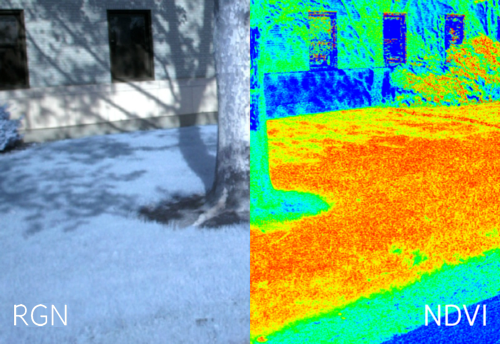](/i/45468?s=o) **** ## NRG imagery Some people are also interested in producing NRG imagery (like the below image), where `Near-Infrared, Red, and Green` are used to compose a picture instead of the usual `Red, Green, and Blue`. [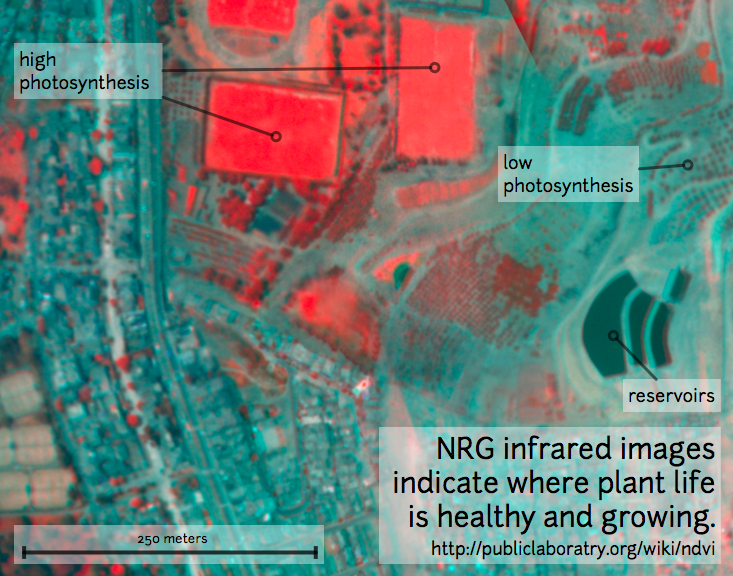](/i/25064) This diagram explains the swapping, which allows us to 'see' infrared as if it were a normal color: [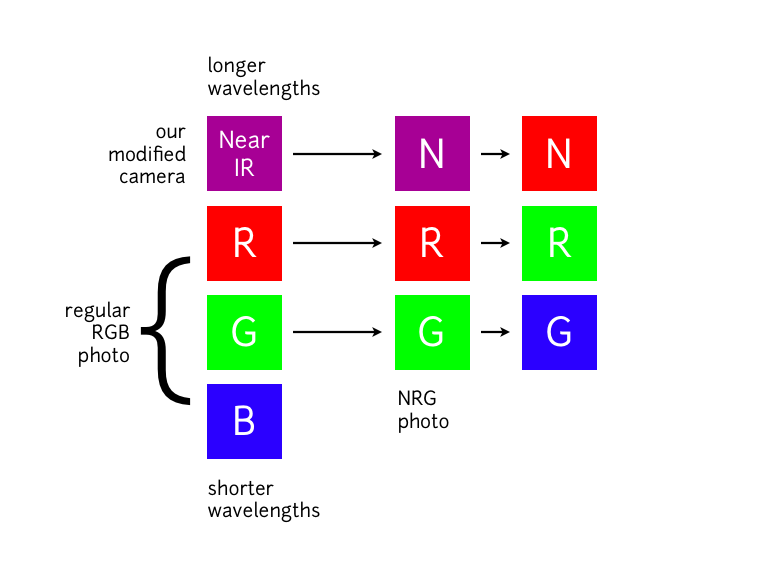](/i/25063) **In NRG images, the deeper and clearer the red color, the denser and healthier the vegetation (more or less).** ### Questions [questions:ndvi] ### Other examples of DIY NDVI imaging From around the internet: Begin watching at 2 minutes to see the resulting imagery: *This topic is part of the [Grassroots Mapping Curriculum](/wiki/mapping-curriculum) series.* **** [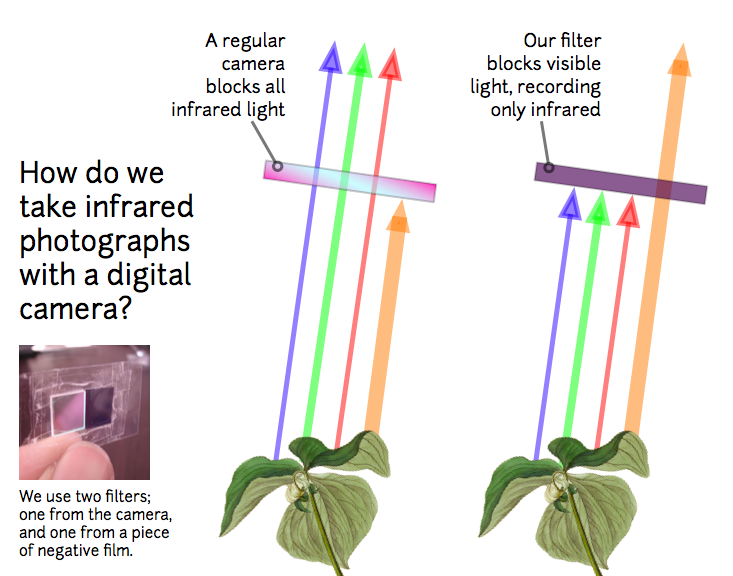](/i/25066) [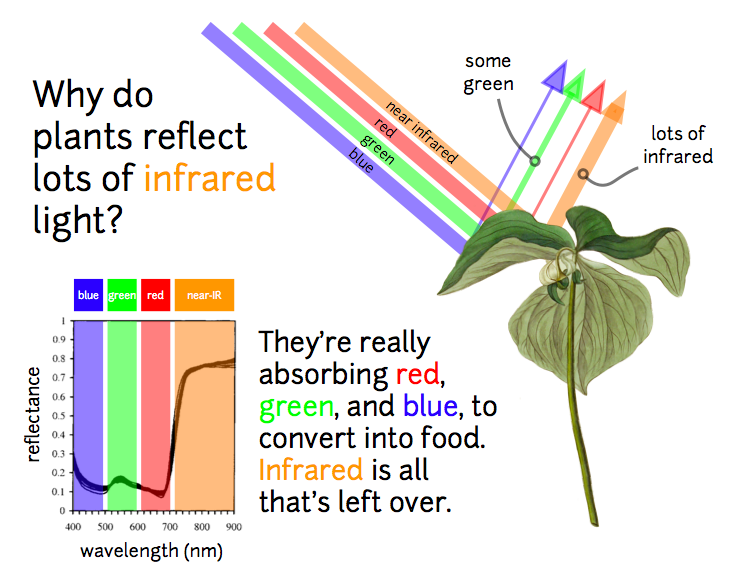](/i/25065) ...
| Author | Comment | Last activity | Moderation | ||
|---|---|---|---|---|---|
| suman | "Some initial results using your white balance settings are impressive, however in this particular picture the roof of the house is showing high pho..." | Read more » | over 7 years ago | |||
| suman | "Dear All, As i was going through some literature, i found an interesting paper, "A Mixture of Barium Sulfate and White Paint is a Low-..." | Read more » | over 7 years ago | |||
| suman | "Hello Ned, Thank you so much for your prompt reply.I appreciate it. Sure, will do .. " | Read more » | over 7 years ago | |||
| nedhorning | "Hi Suman, I do not have a peer reviewed manuscript about this work so suggest citing this web page using a style appropriate for websites or blogs...." | Read more » | over 7 years ago | |||
| suman | "Thank you so much Ned for such interesting post. I was keen to know on how i can cite your works for any possible publications. Do you have any pub..." | Read more » | over 7 years ago | |||
| nedhorning | "Hi sujayj - I uploaded files with the target descriptions and reflectance information to my Google Drive: https://drive.google.com/drive/folders/0B..." | Read more » | over 7 years ago | |||
| sujayj | "@cfastie This is very interesting. Thank you! " | Read more » | over 7 years ago | |||
| sujayj | "@nedhorning I have been looking to carry out calibration but was halted by the expensive costs of targets. After reading through your article, I re..." | Read more » | over 7 years ago | |||
| cfastie | "Yes, we are going to change the pixel values in our photo. For each pixel in the photo we have taken of vegetation, we use the DN in the red channe..." | Read more » | over 7 years ago | |||
| sujayj | "@cfastie This is a very informative article. However, It isn't clear what is to be done after obtaining the final graph as you've shown. Are we goi..." | Read more » | over 7 years ago | |||
| nedhorning | "Hi jenjimah, Testing any of these and reporting back would be worthwhile from my perspective. One word of caution is that these are very bright re..." | Read more » | over 7 years ago | |||
| jenjimah | "Hello Ned, thank you for all your work on this subject. Currently I am looking for low-cost materials that can be used as reliable standards for N..." | Read more » | over 7 years ago | |||
| BenR | "@khufkens did you set a white balance on the Raspberry Pi for the Infrared image? I use a NoIR V2 camera with the Thorlabs RG9 longpass filter. " | Read more » | almost 8 years ago | |||
| bwarzak | "I agree with Chris. Narrower bands, when they are optimally centered, logically will work better, particularly because - virtually inherent with in..." | Read more » | almost 8 years ago | |||
| reversevector | "I'm using an SJCam 4000, it's a cheap GoPro clone. It doesn't have custom white balance settings so I'm using incandescent with a red filter. I'm a..." | Read more » | almost 8 years ago | |||
| cfastie | "Some blue filters including Wratten 47, Schott BG3, and Rosco 2007 are dual bandpass red-rejection filters. They require that blue light be used fo..." | Read more » | almost 8 years ago | |||
| suman | "I was curious to know which modified camera do you use? For my case, i am testing with Modified Mobius actioncam with wide angle A lens 87mm. If yo..." | Read more » | almost 8 years ago | |||
| suman | "I have just been going through a peer reviewed journal paper named 'Monitoring plant condition and phenology using infrared sensitive consumer grad..." | Read more » | almost 8 years ago | |||
| reversevector | "I'm also using VGYRM although I sometimes have to stretch the NIR value to get good results. " | Read more » | almost 8 years ago | |||
| reversevector | "Since these cheap consumer cameras have a lot of NIR crosstalk, especially with small sensor cameras like the GoPro, would it be better to subtract..." | Read more » | almost 8 years ago | |||
| suman | "The macro was developed by Frank Aldiuos, a member of public labs. It basically is doing same thing as processing from the directory where all the ..." | Read more » | almost 8 years ago | |||
| reversevector | "The Photo Monitoring plugin already has a command that generates NDVI from a folder full of images (Single image index processing from directory). ..." | Read more » | almost 8 years ago | |||
| nedhorning | "I do not have any peer-reviewed papers related to this work - sorry. Ned " | Read more » | almost 8 years ago | |||
| suman | "Dear Ned, Recently i have been going through your interesting works on Infragram NDVI and calibration. I was wondering if you had a..." | Read more » | almost 8 years ago |